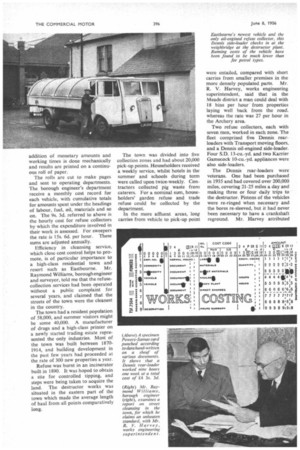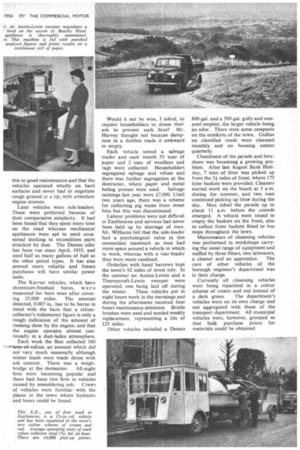Punched Cards Check Eastbourne's Costs
Page 71

Page 72

Page 73

If you've noticed an error in this article please click here to report it so we can fix it.
Mechanized Accountancy, • Readily Affording Analysed Cost Figures, Aids Attainment of High Cleansing Standards : Streets are "Cleanest in the Country" By Alan Smith
THE installation of PowersSamas punched-card costing and record machines in Eastbourne Borough Treasurer's Office has eliminated much of the brainwork involved in keeping municipal accounts. The operations of the borough engineer's department which include refuse collection and street cleansing, are among the activities under mechanical cost control.
The system is dependent upon the definition of vehicles, specific jobs and various classes of material and labour by code numbers, which are scheduled for quick reference. Coded data on hand-written time sheets, material-issue forms and other documents are weekly passed to the treasurer's department.
From this codified information, a machine operator punches cards appropriately. This is repeated by a second operator whose machine is offset 1/32 in. Resulting holes converge and form a shape like an 8. If one operator has made a mistake in codifying, there will be two separate circular holes in a column. The cards are next passed through a machine which will reject a card every hole in which is not 8-shaped, and errors are thus discovered.
With a set of correctly punched cards, each of which contains as much information as a handful of dockets, collation and analysis of data is a speedy mechanical process. A specimen card is reproduced overleaf actual size. It is divided into vertical sections of varying widths, each section containing one or more columns. Each column is headed by a numeral. In the first vertical column are digits 1-9. A hole anywhere on the card has the value of the digit to its left.
The holes in the first column indicate that the activity is haulage. In the second column appears a hole against 3 and another against 1. This refers to haulage class 3, which is refuse collection, and vehicle No. 1 in that class, actually a Dennis rearloader.
The next column, headed 7, is punched so that when analysis sheets are printed on a machine, relevant wording will be given alphabetically: code numbers, which would need translation, would not appear alone. In the fourth column is seen a hole against 5 and, to its right, another against 4. This indicates 54, the number of the hand-written sheet from which the information on the punched card was abstracted.
Five holes are punched in the next column in the centre of the card. These signify two numbers, 53 and 141. Fifty-three is the number of the municipal pay week. (In the financial year selected, Eastbourne had 53 weeks, one being added to the normal 52 for simplifying P.A.Y.E. calculations.) The 141 is the code number of the job to which the Dennis' hourly operating cost, in fact, 9s. 3d., is chargeable.
In the next column is a hole on a level with 9 on the left to show that the Dennis worked nine hours that week, and finally are three holes signifying £4 3s. 3d., or nine times 9s. 3d., the total cost of operation of the vehicle. In this last column, the vertical row of digits as appears in the first column is repeated seven times.
It is possible to collate data on the punched cards under any desired heading. There is a machine for sorting the cards so that, for example, total costs for any specific operation or the numbers of hours worked by vehicles in any class can be gained. A pile of cards is put into the machine which "deals" them into individual piles. When the separate sets of cards are put into another machine. such as that illustrated on page 396; addition of monetary amounts and working times is done mechanically and results are printed on a continuous roll of paper.
The rolls are cut to make pages and sent to operating departments. The borough engineer's department receive a monthly cost record for each vehicle, with cumulative totals for amounts spent under the headings of labour, fuel, oil, materials and so on. The 9s. 3d. referred to above is the hourly cost for refuse collectors by which the expenditure involved in their work is assessed. For sweepers the rate is 15s. 6d. per hour. These sums are adjusted annually.
Efficiency in cleansing service, which close cost control helps to promote, is of particular importance to a high-class residential town and resort such as Eastbourne. Mr. Raymond Williams, borough engineer and surveyor, told me that the refusecollection services had been operated without a public complaint for several years, and claimed that the streets of the town were the cleanest in the country.
The town had a resident population of 58,000, and summer visitors might be some 40,000. A manufacturer of drugs and a high-class printer on a newly started trading estate represented the only industries. Most of the town was built between 18701914, and building development in the past few years had proceeded at the rate of 300 new properties a year.
Refuse was burnt in an incinerator built in 1890. It was hoped to obtain a site for controlled tipping, and steps were being taken to acquire the land. The destructor works was situated in the eastern part of the town which made the average length of haul from all points comparatively long. The town was divided into five collection zones and had about 20,000 pick-up points. Householders received a weekly service, whilst hotels in the summer and schools during term were called upon twice-weekly. Contractors collected pig waste from caterers. For a nominal sum, householders' garden refuse and trade refuse could be collected by the department.
In the more affluent areas, long carries from vehicle to pick-up point were entailed, compared with short carries from smaller premises in the more densely populated parts. Mr. R. V. Harvey, works engineering superintendent, said that in the Meads district a man could deal with 18 bins per hour from properties laying well back from the road. whereas the rate was 27 per hour in the Archery area.
Two refuse collectors, each with seven men, worked in each zone. The fleet comprised five Dennis rearloaders with Transport moving floors. and a Dennis oil-engined side-loader. Four S.D. 13-cu.-yd. and two Karrier Gamecock 10-cu.-yd. appliances were also side-loaders.
The Dennis rear-loaders were veterans. One had been purchased in 1935 and had covered over 200,000 miles, covering 21-25 miles a day and making three or four daily trips to the destructor. Pistons of the vehicles were re-ringed when necessary and the bores re-sleeved, but it had never been necessary to have a crankshaft reground. Mr. Harvey attributed this to good maintenance and that the vehicles operated wholly on hard surfaces and never had to negotiate rough ground at a tip, with attendant engine stresses.
Later vehicles were side-loaders. These were preferred because of their comparative simplicity. It had been found that they spent more time on the road whereas mechanical appliances were apt to need occasional docking to recondition parts attacked by dust. The Dennis oiler has been run since April, 1955, and used half as many gallons of fuel as the other petrol types. It has also proved more reliable and future purchases will have similar power units.
The Kamer vehicles, which have chromium-finished bores, were measured for bore wear after covering 25,000 miles. The amount detected, 0.007 in., has to be borne in mind with the facts that a ref usecollector's mileometer figure is only a rough indication of the amount of running done by the engine, and that the engine operates almost continually in a dust-laden atmosphere.
Each week the fleet collected 360 -..uletiss-ofs-refuse, an amount which did not vary much seasonally although winter loads were made dense with ash content. There was a weighbridge at the destRictor.
fires were becoming popular and there had been two fires in vehicles caused by smouldering ash. Crews of vehicles were familiar with the places in the town where hydrants and hoses could be found. Would it not be wise, I asked, to require householders to douse their ash to prevent such fires? Mr. Harvey thought not because dampness in a dustbin made it awkward to empty.
Each vehicle towed a salvage trailer and each month 55 tons of paper and 2 tons of woollens and rags were collected. Householders segregated salvage and refuse and there was further segregation at the destructor, where paper and metal baling presses were used. Salvage earnings last year were £7,000. Until two years ago, there was a scheme for collecting pig waste from street bins but this was discontinued.
Labour problems were not difficult in Eastbourne and services had never been held up by shortage of men. Mr. Williams felt that the side-loader had a psychological value in this connection inasmuch as men had more space around a vehicle in which to work, whereas with a rear-loader they were more confined.
Orderlies with hand barrows kept the town's 92 miles of street tidy. In the summer an Austin-Lewin and a Thornycroft-Lewin sweeper were operated, one being laid off during the winter. These vehicles put in eight hours work in the mornings and during the afternoons received four hours maintenance attention. Bristle brushes were used and needed weekly replacement, representing a life of 125 miles.
Other vehicles included a Dennis 800-gal. and a 500-gal. gully and cesspool emptier, the larger vehicle being an oiler. There were some cesspools on the outskirts of the town. Gullies on classified roads were cleansed monthly and on housing estates quarterly.
Cleanliness of the parade and foreshore was becoming a growing problem. After last August Bank Holiday, 7 tons of litter was picked up from the 21 miles of front, where 175 litter baskets were provided. Cleaners started work on the beach at 5 a.m. during the summer, and two men continued picking up litter during the day. Men tidied the parade up to about 11 a.m. before the crowds emerged. A vehicle went round to empty the baskets on the front, also to collect from baskets fitted to bus stops throughout the town.
Maintenance of cleansing vehicles was performed in workshops carrying the usual range of equipment and staffed by three fitters, two labourers, a cleaner and an apprentice. The care of other vehicles of the borough engineer's department was in their charge.
Currently all cleansing vehicles were being repainted in a colour scheme of cream and red instead of a dark green. The department's vehicles were on its own charge and not aggregated with those of the transport department. All municipal vehicles were, however, grouped so that bulk purchase prices for materials could be obtained.




















































































































































